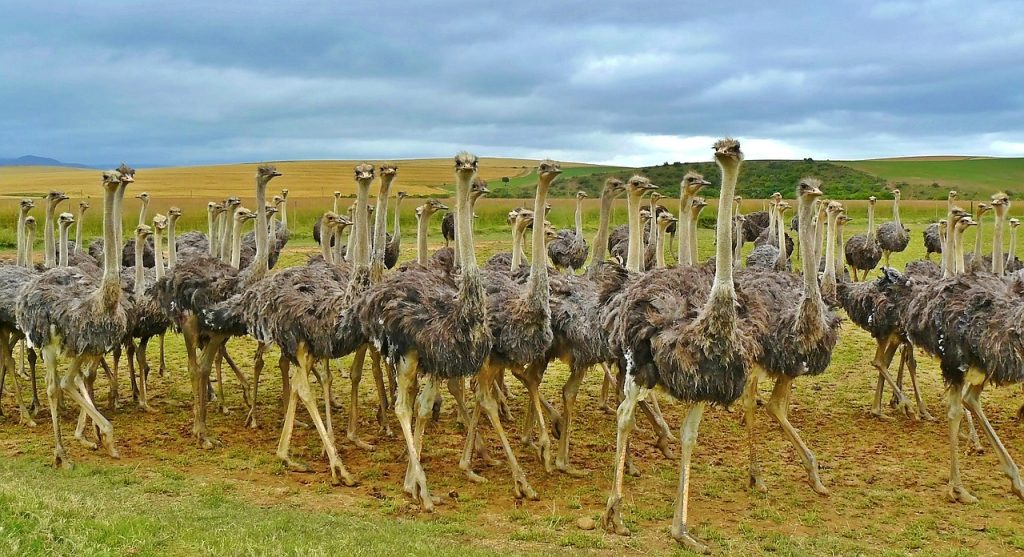Ostriches, the world’s largest birds, are a fascinating and iconic part of Tanzania’s wildlife. Known for their remarkable speed, striking appearance, and unique behaviors, these flightless birds are a common sight in several of Tanzania’s national parks. This article explores the characteristics, habitats, and conservation status of ostriches in Tanzania, offering insights into where and how to observe these incredible creatures.
Characteristics of Ostriches
- Size and Appearance: Ostriches are the largest birds on Earth, with males reaching heights of up to 9 feet and weights of over 300 pounds. They have long, powerful legs, a long neck, and a small head. Males typically have black feathers with white wingtips and tail feathers, while females and young birds have brownish-gray plumage.
- Speed and Movement: Ostriches are renowned for their speed and endurance. They can run at speeds of up to 45 miles per hour, making them the fastest land birds. Their powerful legs are not only built for speed but also for delivering strong kicks to defend against predators.
- Diet: These omnivorous birds primarily feed on plant matter, including seeds, leaves, and flowers, but they also consume insects and small vertebrates. Their diet is supplemented with pebbles and sand to aid in digestion.
- Behavior: Ostriches are social birds, often found in groups called herds. During the breeding season, males perform elaborate courtship displays, including dancing and booming calls to attract females.
Habitat and Distribution in Tanzania
Ostriches are well-adapted to a variety of habitats, including savannas, grasslands, and semi-arid regions. In Tanzania, they are predominantly found in open landscapes where they can easily spot predators and forage for food. Some of the best national parks and conservation areas to observe ostriches in Tanzania include:
Serengeti National Park
- Habitat: The vast open plains of the Serengeti provide an ideal environment for ostriches. Here, they can often be seen grazing and interacting with other herbivores such as zebras and antelopes.
- Significance: The Serengeti is renowned for its wildlife diversity and offers numerous opportunities for visitors to observe ostriches in their natural habitat, especially during the annual Great Migration.
Ngorongoro Conservation Area
- Habitat: The Ngorongoro Crater’s grasslands are home to a healthy population of ostriches. The open landscape and abundant food supply make it a suitable environment for these birds.
- Significance: The crater’s unique ecosystem supports a wide range of species, making it a prime location for birdwatching and wildlife photography.
Tarangire National Park
- Habitat: Tarangire’s diverse habitats, including grasslands and open woodlands, provide suitable living conditions for ostriches. The park is also known for its large elephant herds and baobab trees.
- Significance: The presence of ostriches adds to the park’s rich biodiversity, making it a popular destination for tourists seeking to experience Tanzania’s wildlife.
Lake Manyara National Park
- Habitat: The alkaline lake and surrounding savannas of Lake Manyara National Park support a variety of bird species, including ostriches.
- Significance: While the park is famous for its tree-climbing lions and diverse birdlife, ostriches are also a common sight, particularly in the drier areas of the park.
Arusha National Park
- Habitat: Although smaller in size compared to other parks, Arusha National Park’s varied ecosystems, from montane forests to savannas, provide habitats for a range of wildlife, including ostriches.
- Significance: The park’s proximity to Arusha city makes it an accessible destination for day trips and short safaris, where visitors can enjoy sightings of ostriches and other wildlife.
Conservation Status and Efforts
Ostriches in Tanzania, like many wildlife species, face threats from habitat loss, human-wildlife conflict, and climate change. However, concerted conservation efforts are in place to protect these iconic birds and their habitats:
- Protected Areas: Tanzania’s national parks and conservation areas provide safe havens for ostriches, safeguarding them from poaching and habitat encroachment.
- Research and Monitoring: Continuous research and monitoring efforts help in understanding ostrich populations, behavior, and ecology, informing conservation strategies.
- Community Involvement: Engaging local communities in conservation initiatives and promoting sustainable tourism practices contribute to the protection of ostriches and their habitats.
Observing Ostriches in Tanzania
For wildlife enthusiasts and birdwatchers, Tanzania offers numerous opportunities to observe ostriches in their natural habitats. Safari tours and guided game drives in national parks provide close encounters with these magnificent birds. To enhance your chances of spotting ostriches:
- Visit during Dry Season: The dry season, from June to October, is generally the best time to see ostriches as they congregate around water sources and open areas.
- Early Morning and Late Afternoon: Ostriches are more active during the cooler parts of the day, making early morning and late afternoon the best times for sightings.
- Guided Tours: Opt for guided tours with experienced rangers who can help locate and provide insights into the behavior and ecology of ostriches.
Conclusion
Ostriches are a vital part of Tanzania’s rich wildlife heritage, captivating visitors with their impressive size, speed, and intriguing behaviors. Through dedicated conservation efforts and sustainable tourism practices, Tanzania continues to protect and celebrate these remarkable birds. A visit to Tanzania’s national parks offers a unique opportunity to witness ostriches in their natural environments, contributing to the appreciation and preservation of one of Africa’s most iconic species.







